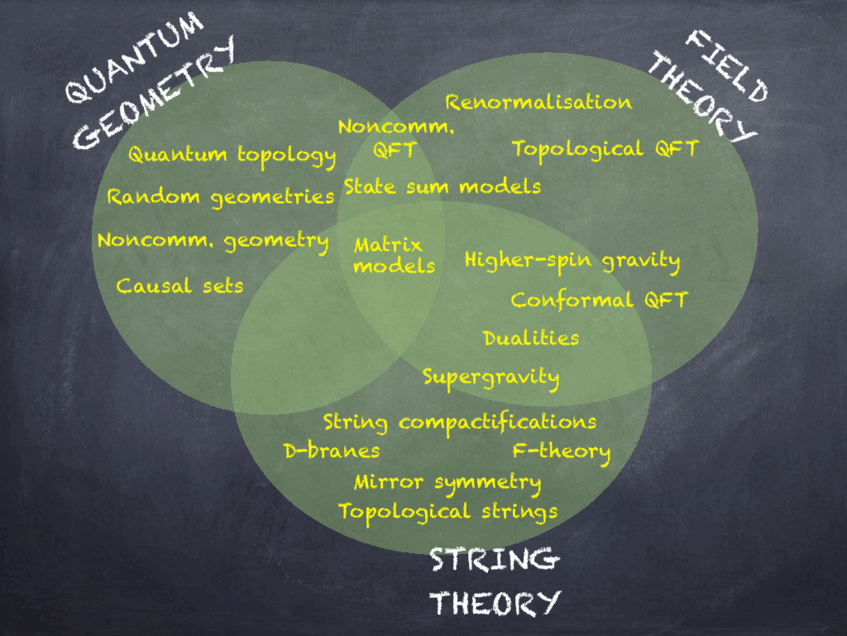Mathematical Physics

Mathematical Physics
The research pursued in the Mathematical Physics group deals with the mathematical structures of fundamental interactions including approaches to quantum gravity. It covers a range of topics in field theory, quantum geometry and string theory.
In physics, we have by now acquired a deep understanding of the interactions that apparently govern all processes that we observe in the universe. The fundamental interactions have been identified as the electromagnetic, weak and strong nuclear force, and gravity. Whereas gravity is described by Einstein's theory of general relativity in terms of a curved space-time geometry, the other forces are described by quantum field theories. Although highly developed, there are still many fundamental (physical and mathematical) questions within these theories which remain open. Even more unsatisfactory is the fact that quantum field theory and general relativity do not seem to be compatible; we are missing a theory of quantum gravity that could unify these descriptions.
There are different approaches to quantum gravity; some of them concentrate on generalisations of geometry like noncommutative geometry or quantum topology, and others try to extend gravity (and the other interactions) into a larger framework like string theory, supergravity or matrix models, to address the issue of quantisation there.
In our group we approach these fundamental questions in different, but often intertwined research directions including:
- symmetries of quantum field theories and gauge theories
- higher-spin gravity and holography
- matrix models and the quantum structure of space-time and gravity
- topological and conformal quantum field theory
- supersymmetric quantum field theories
Our researchers
The researchers from the Mathematical Physics Group at the University of Vienna specialize in the intersection of mathematics and physics, focusing on areas such as quantum field theory, statistical mechanics, and the mathematical foundations of quantum mechanics. Their work involves rigorous mathematical methods to address fundamental questions in physics, and they have published extensively in top-tier journals. In addition to their research, they are actively involved in mentoring students and collaborating with international experts to advance their fields of inquiry,
Nils Carqueville

Nils Carqueville
My research is chiefly about (topological) quantum field theory. Using the language of algebra, topology, and higher category theory, we aim to gain conceptual insight into quantum physics and related pure mathematics. Applications include so-called generalised symmetries via topological defects, and descriptions of topological phases of matter.
Further reading: Introductory lectures notes on TQFT and 2d defect TQFTs; recent surveys on orbifold construction and topological defects.
Stefan Fredenhagen

© Barbara Mair
Stefan Fredenhagen
My research deals with theoretical and mathematical questions in field theory, gravity and generalisations thereof, in particular I am interested in higher-spin gravities and conformal field theories. Higher-spin gravities generalise ordinary gauge theories like Yang-Mills theory or general relativity by fields of higher spins. They show an interesting relation to conformal field theories with global higher-spin charges via holography — for an introduction in the context of 3-dimensional higher-spin gravity, see our recent lecture notes.
Personal site: https://homepage.univie.ac.at/stefan.fredenhagen/
Stefan Prohazka

Stefan Prohazka
My research focuses on the mathematical and physical aspects of symmetries, exploring their underlying structures and their far-reaching implications across various fields.
This encompasses the classification and gauging of (exotic) spacetime symmetries as well as the study of relation between asymptotic symmetries, memory effects and soft theorems. Recently, much of my work have been focused on carrollian symmetries and their relation to flat space holography and on theories with dipole symmetries which lead to novel particles ("fractons"). For more information about my research, please visit my site.
Personal site: https://sites.google.com/site/prohazkast/outreach
Marcus Sperling

Marcus Sperling
My work delves into the fundamental aspects of quantum field theories (QFTs), focusing on symmetries and vacua. By exploring supersymmetric theories as a laboratory for QFTS, we uncover a rich dialogue between geometry, algebra, and physics. This fusion not only leverages modern mathematics to unlock precise insights into complex, strongly coupled, or even non-Lagrangian theories, but also paves new ways to illuminate mathematics through the lens of physics.
Project quiverQFT: https://quiverqft.univie.ac.at/
Open to Master projects
Harold Steinacker

Harold Steinacker
"The motivation of my research is the long-term quest towards a quantum theory of fundamental interactions including gravity. Specifically, I'm developing and following an approach known as „Matrix Theory“, focusing on the IKKT or IIB matrix model. This can be viewed as a constructive approach to string theory, which avoids the "landscape" problem and its inherent lack of predictivity.The underlying matrix model is extremely simple, and leads naturally to a quantum structure of space-time. A central aspect of this programe is to establish a suitable notion of quantum geometry, which is fairly well developed by now. The goal in the next years is to develop further the required mathematical framework and tools,
to understand the emergent physics on such quantum space-times, and to assess the physical viability of the framework.
Homepage: https://homepage.univie.ac.at/harold.steinacker/
Open to Master projects (require a strong background in theoretical & mathematical physics, as well as numerical skills)
Ödül Tetik

Ödül Tetik
My current work concerns extending the bulk description of a classical or quantum theory to higher-codimension objects, such as boundaries, corners, or defect submanifolds. This requires -- and informs -- a great many ideas from topology and algebra, and sets the stage for an understanding of physical issues such as (defect) coupling and quantisation in this context. Major advances from past decades are revealed to be the first steps in larger programs that are currently wide open.
Personal website: https://o-tetik.github.io/
Subgroup website: https://carqueville.net/nils/group.php
Open to Master projects
